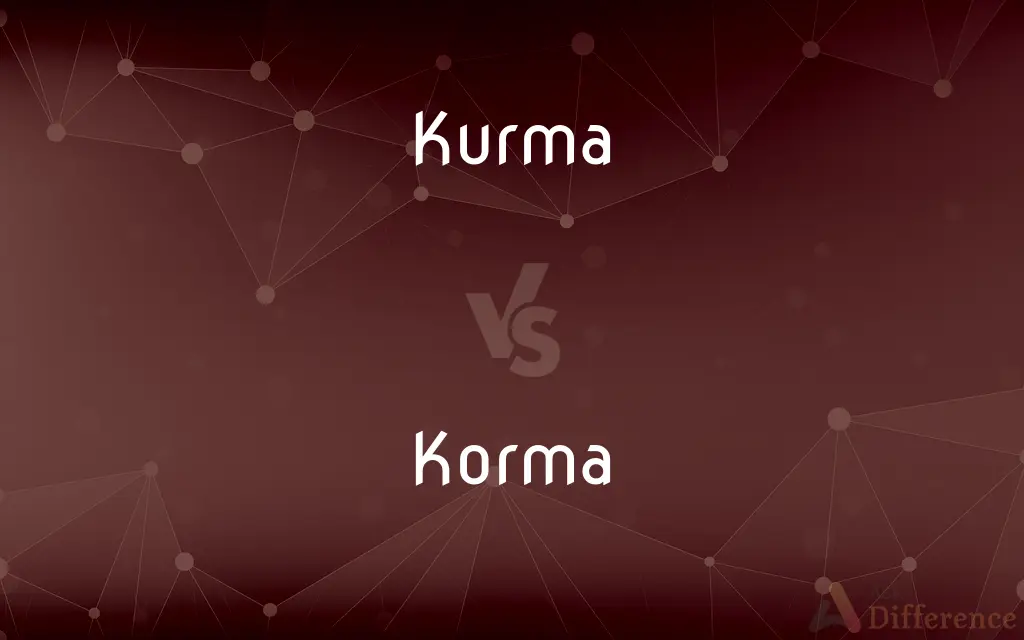Kurma vs. Korma — What's the Difference?
Edited by Tayyaba Rehman — By Urooj Arif — Updated on March 29, 2024
Kurma is a spiced dish originating from South India featuring vegetables or meat, characterized by a coconut-based sauce, while Korma is a Mughlai dish from North India, known for its creamy, nutty sauce and gentle spices.

Difference Between Kurma and Korma
Table of Contents
ADVERTISEMENT
Key Differences
Kurma, also spelled as Kurma, is a term deeply rooted in South Indian cuisine. It refers to a variety of dishes that include vegetables or meat cooked in a spicy and aromatic sauce made predominantly from coconut, seeds, and a mix of specific South Indian spices. On the other hand, Korma, which has origins in the Mughlai cuisine of North India, is recognized for its rich, creamy texture achieved by using yogurt, cream, nut pastes, and a delicate blend of spices including cardamom and cinnamon.
While Kurma uses a coconut base for its sauce, contributing to a distinct flavor and texture that's often lighter and infused with tamarind for a touch of sourness, Korma's sauce is typically heavier, relying on dairy products and ground nuts to create a smooth, rich consistency. Moreover, Korma sometimes includes a slight sweetness and is generally less spicy than Kurma, catering to different palates.
The spices used in Kurma are robust, featuring a mix that often includes curry leaves, mustard seeds, and chillies, reflecting the vibrant spice culture of South India. Conversely, Korma utilizes a subtler spice mix, favoring the aromatic rather than the spicy, with ingredients like saffron and mace to achieve its characteristic flavor profile.
In terms of preparation, Kurma often sees the spices tempered in oil before adding the main ingredients, which is a common technique in South Indian cooking, enhancing the flavors of the dish. Korma, however, may involve marinating the main ingredient in yogurt and spices before slow-cooking it to perfection, allowing for a deep infusion of flavors.
Despite these differences, both dishes hold significant places within their respective culinary traditions, celebrated for their depth of flavor and the skill required in their preparation. Whether one prefers the coconut-infused vibrancy of a Kurma or the creamy, nutty richness of a Korma can depend on individual taste and the culinary journey one wishes to embark on.
ADVERTISEMENT
Comparison Chart
Origin
South India
North India, specifically Mughlai cuisine
Base Ingredients
Coconut milk or grated coconut
Yogurt, cream, and nut pastes
Key Spices
Curry leaves, mustard seeds, chillies
Cardamom, cinnamon, saffron
Texture
Lighter and slightly more liquid
Creamy and thick
Flavor Profile
Spicy with a possible touch of sourness from tamarind
Mild, slightly sweet, and aromatic
Cooking Technique
Spices tempered in oil, then mixed with main ingredients
Main ingredient marinated, then slow-cooked with spices
Typical Use
Accompaniment to rice or flatbreads
Served with naan, rice, or breads
Compare with Definitions
Kurma
Often includes a tangy element like tamarind.
The tanginess in the kurma was balanced beautifully with the coconut.
Korma
A creamy, Mughlai dish with nuts and mild spices.
The chicken korma had a rich, nutty flavor that was irresistible.
Kurma
A South Indian dish with vegetables or meat in a coconut-based sauce.
The vegetable kurma was a perfect blend of spices and coconut.
Korma
Known for its smooth, thick sauce.
The sauce in the korma was perfectly creamy, coating every piece of meat.
Kurma
Characterized by its aromatic and spicy flavor profile.
The chicken kurma filled the room with its inviting aroma.
Korma
Often less spicy, with a hint of sweetness.
The korma offered a gentle, sweet flavor unlike any other curry.
Kurma
Accompanied typically with rice or flatbreads.
We enjoyed the mutton kurma with steamed rice.
Korma
Typically served with naan or rice.
Pairing the vegetable korma with garlic naan was a delightful choice.
Kurma
Reflects the vibrant spice culture of South India.
The kurma showcased a variety of spices unique to South Indian cuisine.
Korma
Utilizes dairy products for its creamy texture.
The use of yogurt in the korma added a delightful creaminess.
Kurma
Kurma (Sanskrit: कूर्म; Kūrma, 'turtle', 'tortoise'), is an avatar of the Hindu god Vishnu. Originating in Vedic literature such as the YajurVeda as being synonymous with the Saptarishi called Kasyapa, Kurma is most commonly associated in post-Vedic literature such as the Puranas with the legend of the churning of the Ocean of Milk, referred to as the Samudra manthan.
Korma
Korma or qorma is a dish originating in the Indian subcontinent, consisting of meat or vegetables braised with yogurt (dahi) or cream, water or stock, and spices to produce a thick sauce or gravy.
Kurma
Alternative form of korma
Korma
A dish of South Asian origin in which meat or vegetables are braised or simmered in a rich, highly seasoned sauce thickened with ground nuts, yogurt or cream, and sometimes coconut.
Korma
A curry made from various spices especially coriander and cumin; and often with yoghurt sauce or nuts.
Common Curiosities
How is Korma different from Kurma?
Korma, originating from North India, is a creamy, nut-based curry with mild spices, contrasting with Kurma's spicier, coconut-based sauce.
Why is Kurma spicy?
Kurma's spiciness comes from the use of chillies and a blend of South Indian spices, reflecting the region's culinary preferences.
Can Kurma be made without coconut?
Traditionally, coconut is a key ingredient in Kurma, but variations may substitute it with poppy seeds or nuts for different textures and flavors.
Is Korma considered a festive dish?
Yes, Korma is often prepared for special occasions and festivals, thanks to its rich and indulgent nature.
Is Korma vegetarian?
Korma can be made with meat or as a vegetarian dish, utilizing a variety of vegetables or paneer.
What is Kurma?
Kurma is a South Indian dish featuring a coconut-based sauce with vegetables or meat, distinguished by its spicy and aromatic flavor.
What makes Kurma a popular dish in South India?
Its versatility, robust flavors, and compatibility with rice and flatbreads make Kurma a staple in South Indian cuisine.
Can Korma be made without nuts for someone with allergies?
Yes, though nuts contribute to its creaminess, alternatives like seeds or heavy cream can be used to adapt the recipe for allergies.
What is the nutritional value of Kurma?
The nutritional value depends on the ingredients used; vegetable Kurma can be a source of vitamins, while meat versions provide protein.
Can Korma be considered a healthy dish?
While rich and creamy, Korma can be part of a balanced diet if consumed in moderation and made with lean meats or vegetables.
How important is the use of spices in Kurma?
Spices play a crucial role in defining Kurma's flavor profile, with each spice adding depth and aroma to the dish.
What sides are typically served with Korma?
Korma is commonly served with naan, rice, or other breads, which complement its creamy texture and rich flavors.
How can one achieve the creamy texture of Korma without dairy?
For a dairy-free version, coconut milk or cashew paste can be used as substitutes to achieve a similar creamy consistency.
Does Kurma always include meat?
No, Kurma can be prepared with meat or as a purely vegetarian dish, including a variety of vegetables.
How has the recipe for Kurma evolved over time?
While staying true to its roots, Kurma recipes have evolved with regional variations, incorporating local ingredients and preferences.
Share Your Discovery

Previous Comparison
Seraphim vs. Archangel
Next Comparison
Drawing vs. LayoutAuthor Spotlight
Written by
Urooj ArifUrooj is a skilled content writer at Ask Difference, known for her exceptional ability to simplify complex topics into engaging and informative content. With a passion for research and a flair for clear, concise writing, she consistently delivers articles that resonate with our diverse audience.
Edited by
Tayyaba RehmanTayyaba Rehman is a distinguished writer, currently serving as a primary contributor to askdifference.com. As a researcher in semantics and etymology, Tayyaba's passion for the complexity of languages and their distinctions has found a perfect home on the platform. Tayyaba delves into the intricacies of language, distinguishing between commonly confused words and phrases, thereby providing clarity for readers worldwide.















































